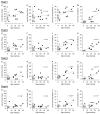The attribution of incentive salience to Pavlovian alcohol cues: a shift from goal-tracking to sign-tracking
- PMID: 25784867
- PMCID: PMC4347508
- DOI: 10.3389/fnbeh.2015.00054
The attribution of incentive salience to Pavlovian alcohol cues: a shift from goal-tracking to sign-tracking
Abstract
Environmental stimuli that are reliably paired with alcohol may acquire incentive salience, a property that can operate in the use and abuse of alcohol. Here we investigated the incentive salience of Pavlovian alcohol cues using a preclinical animal model. Male, Long-Evans rats (Harlan) with unrestricted access to food and water were acclimated to drinking 15% ethanol (v/v) in their home-cages. Rats then received Pavlovian autoshaping training in which the 10 s presentation of a retractable lever served as the conditioned stimulus (CS) and 15% ethanol served as the unconditioned stimulus (US) (0.2 ml/CS; 12 CS presentations/session; 27 sessions). Next, in an operant test of conditioned reinforcement, nose pokes into an active aperture delivered presentations of the lever-CS, whereas nose pokes into an inactive aperture had no consequences. Across initial autoshaping sessions, goal-tracking behavior, as measured by entries into the fluid port where ethanol was delivered, developed rapidly. However, with extended training goal-tracking diminished, and sign-tracking responses, as measured by lever-CS activations, emerged. Control rats that received explicitly unpaired CS and US presentations did not show goal-tracking or sign-tracking responses. In the test for conditioned reinforcement, rats with CS-US pairings during autoshaping training made more active relative to inactive nose pokes, whereas rats in the unpaired control group did not. Moreover, active nose pokes were positively correlated with sign-tracking behavior during autoshaping. Extended training may produce a shift in the learned properties of Pavlovian alcohol cues, such that after initially predicting alcohol availability they acquire robust incentive salience.
Keywords: autoshaping; conditioned reinforcement; conditioned stimulus; ethanol; motivation; rat.
Figures








References
Grants and funding
LinkOut - more resources
Full Text Sources
Other Literature Sources

